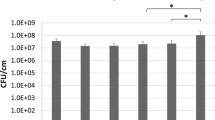Summary
The various intrinsic bladder mucosal defenses against bacterial invasion, including the anti-adherence action of the surface mucopolysaccharide layer, have been documented in recent years. Studies have suggested Heparin, a mucopolysaccharide, may have anti-adherence action. We used scanning electron microscopy to visually evaluate the effects of intravesical HCl, Heparin and Protamine on the interaction between E. coli and rat bladders. Our findings concurred with previous statistical analyses using radio-isotope labelled bacteria, suggesting a beneficial anti-adherence effect of Heparin which can be negated by Protamine. We also noted a white coating on the bacteria in bladders treated with Heparin. We suggest this may represent minute amounts of Heparin coating the bacteria, thus decreasing bacterial adherence to bladder mucosa. Analogues of Heparin, without anti-coagulant properties, may be useful in prophylaxis against urinary tract infections.
Similar content being viewed by others
References
Levin S, Richter WR (1975) Ultrastructure of cell surface coat (Glycocalyx) in rat urinary bladder epithelium. Cell Tiss Res 158:281
Parsons CL, Greenspan C, Mulholland SG (1975) The primary antibacterial defense mechanism of the bladder. Invest Urol 13:72
Monis B, Dorfman HD (1967) Some histochemical observations on transitional epithelium of man. J Histochem Cytochem 15:475
Koss LG (1969) The asymmetric unit membranes of epithelium of the urinary bladder of the rat: An electron microscopic study of a mechanism of epithelial maturation and function. Lab Invest 21:154
Parsons CL, Shrom SH, Hanno PM, Mulholland SG (1978) Bladder surface mucin: Examination of possible mechanisms for its antibacterial effects. Invest Urol 16:196
Parsons CL, Mulholland SG (1978) Bladder surface mucin: its antibacterial effect against various bacterial species. Am J Pathol 93:423
Shrom SH, Parsons CL,. Mulholland SG (1977) Role of urothelial surface mucoprotein in intrinsic bladder defense. Urology 9:526
Parsons CL, Greenspan C, Moore SE, Mulholland SG (1977) Role of surface mucin in primary antibacterial defense of bladder. Urology 9:48
Hanno PM, Fritz R, Wein AJ, Mulholland SG (1978) Heparin as antibacterial agent in rabbit bladder. Urology 12:411
Hanno PM, Fritz RW, Mulholland SG, Wein AJ (1981) Heparin —Examination of its antibacterial adsorption properties. Urology, 18:273
Davis CP, Balish E, Muzutani K, Uehling DT (1977) Bladder response to Klebsiella infection: a scanning electron microscopy study. Invest Urol 15:227
Mooney JK, Hinman F (1974) Aging and replacement of the luminal cells in the mammalian bladder studied by scanning electron microscopy. Invest Urol 11:396
Mooney JK, Mooney JS, Himan (1976) The antibacterial effect of the bladder surface: an electron microscopic study. J Urol 115:381
Fukushi Y, Orikasa S, Kagayama M (1979) An electron microscopic study of the interaction between vesical epithelium and E. Coli. Invest Urol 17:61
Karnovsky MJ (1965) A formaldehyde-glutaraldehyde fixative of high osmolality for use in electron microscopy. J Cell Biol 27:137
Skoluda D, Richter IE, Busse K (1974) Experiments in Coli colitis: Scanning electron microscopy of the bladder urothelium. Urol Int 29:299
Uehling DT, Mizutani K, Balish E (1980) Inhibitors of bacterial adherence to urothelium. Invest Urol 18:40
Author information
Authors and Affiliations
Rights and permissions
About this article
Cite this article
Chin, J.L., Sharpe, J.R. The anti-adherence effect of heparin: A visual analysis. Urol. Res. 11, 173–179 (1983). https://doi.org/10.1007/BF00256367
Accepted:
Issue Date:
DOI: https://doi.org/10.1007/BF00256367




